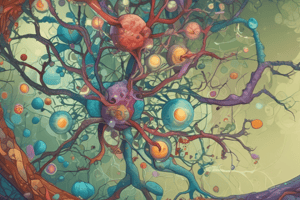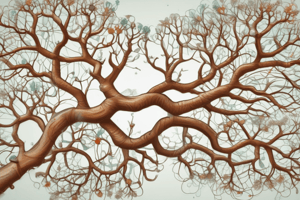Podcast
Questions and Answers
Which branch of biology is the study of plants, including their structure, growth, evolution, and classification?
Which branch of biology is the study of plants, including their structure, growth, evolution, and classification?
Mitochondria is responsible for generating energy for the cell.
Mitochondria is responsible for generating energy for the cell.
True
What is the process by which plants convert light energy into chemical energy?
What is the process by which plants convert light energy into chemical energy?
photosynthesis
The double helix model of DNA is composed of two strands of ______________________ twisted together.
The double helix model of DNA is composed of two strands of ______________________ twisted together.
Signup and view all the answers
Match the following biological processes with their descriptions:
Match the following biological processes with their descriptions:
Signup and view all the answers
What is the primary mechanism of evolution that leads to the survival and reproduction of individuals with advantageous traits?
What is the primary mechanism of evolution that leads to the survival and reproduction of individuals with advantageous traits?
Signup and view all the answers
Ecology is the study of the interactions between organisms and their environment.
Ecology is the study of the interactions between organisms and their environment.
Signup and view all the answers
What is the term for the movement of genes from one population to another?
What is the term for the movement of genes from one population to another?
Signup and view all the answers
The ______________________ of an ecosystem includes living organisms such as plants, animals, and microorganisms.
The ______________________ of an ecosystem includes living organisms such as plants, animals, and microorganisms.
Signup and view all the answers
Which of the following is NOT a component of an ecosystem?
Which of the following is NOT a component of an ecosystem?
Signup and view all the answers
Study Notes
Branches of Biology
- Botany: study of plants, including their structure, growth, evolution, and classification
- Zoology: study of animals, including their structure, growth, evolution, and classification
- Microbiology: study of microorganisms, such as bacteria, viruses, and fungi
- Ecology: study of the interactions between organisms and their environment
Cell Biology
-
Cell Structure:
- Plasma membrane: separates cell from environment
- Cytoplasm: jelly-like substance inside cell
- Nucleus: contains genetic material (DNA)
- Mitochondria: generate energy for cell
-
Cellular Processes:
- Metabolism: chemical reactions that occur within cell
- Photosynthesis: process by which plants convert light energy into chemical energy
- Cell division: process by which cells reproduce
Genetics
-
DNA Structure:
- Double helix model: two strands of nucleotides twisted together
- Nucleotides: building blocks of DNA, consisting of sugar, phosphate, and nitrogenous base
-
Genetic Inheritance:
- Mendel's laws: principles of inheritance, including segregation and independent assortment
- Traits: characteristics inherited from parents, determined by genes
Evolution
- Theory of Evolution: process by which species change over time through natural selection
-
Mechanisms of Evolution:
- Mutation: change in DNA sequence
- Gene flow: movement of genes from one population to another
- Genetic drift: random change in gene frequency
- Natural selection: process by which individuals with advantageous traits are more likely to survive and reproduce
Ecology and Ecosystems
-
Ecosystem Components:
- Biotic factors: living organisms (plants, animals, microorganisms)
- Abiotic factors: non-living components (light, temperature, water, soil)
-
Energy Flow:
- Producers: organisms that convert sunlight into energy (plants, algae)
- Consumers: organisms that obtain energy by consuming other organisms
- Decomposers: organisms that break down dead organic matter
Branches of Biology
- Botany is the study of plants, including their structure, growth, evolution, and classification.
- Zoology is the study of animals, including their structure, growth, evolution, and classification.
- Microbiology is the study of microorganisms, such as bacteria, viruses, and fungi.
- Ecology is the study of the interactions between organisms and their environment.
Cell Biology
Cell Structure
- The plasma membrane separates the cell from its environment.
- Cytoplasm is a jelly-like substance inside the cell.
- The nucleus contains genetic material (DNA).
- Mitochondria generate energy for the cell.
Cellular Processes
- Metabolism refers to the chemical reactions that occur within the cell.
- Photosynthesis is the process by which plants convert light energy into chemical energy.
- Cell division is the process by which cells reproduce.
Genetics
DNA Structure
- DNA is structured as a double helix model, with two strands of nucleotides twisted together.
- Nucleotides are the building blocks of DNA, consisting of sugar, phosphate, and nitrogenous base.
Genetic Inheritance
- Mendel's laws are principles of inheritance, including segregation and independent assortment.
- Traits are characteristics inherited from parents, determined by genes.
Evolution
Theory of Evolution
- The theory of evolution is the process by which species change over time through natural selection.
Mechanisms of Evolution
- Mutation is a change in DNA sequence.
- Gene flow is the movement of genes from one population to another.
- Genetic drift is a random change in gene frequency.
- Natural selection is the process by which individuals with advantageous traits are more likely to survive and reproduce.
Ecology and Ecosystems
Ecosystem Components
- Biotic factors are living organisms (plants, animals, microorganisms).
- Abiotic factors are non-living components (light, temperature, water, soil).
Energy Flow
- Producers are organisms that convert sunlight into energy (plants, algae).
- Consumers are organisms that obtain energy by consuming other organisms.
- Decomposers are organisms that break down dead organic matter.
Studying That Suits You
Use AI to generate personalized quizzes and flashcards to suit your learning preferences.
Description
Explore the different branches of biology, including botany, zoology, microbiology, and ecology, and delve into cell biology, covering cell structure and its components.




